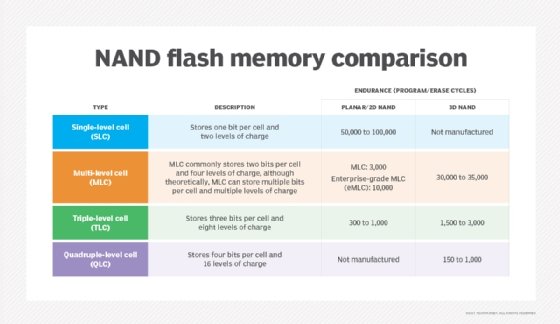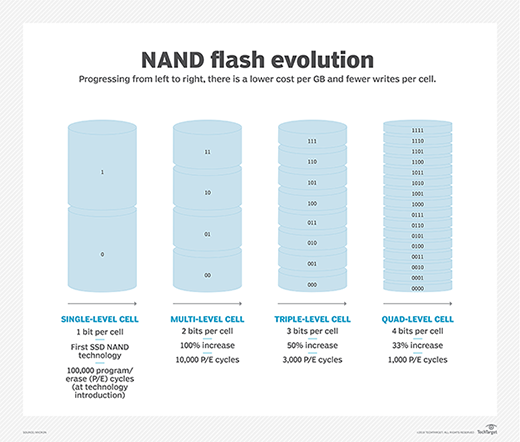SSD write cycle
What is an SSD write cycle?
An SSD write cycle is the process of programming data to a NAND flash memory chip in a solid-state storage device.
A block of data stored on a flash memory chip must be electrically erased before new data can be written, or programmed, to the solid-state drive (SSD). The SSD write cycle is also known as the program/erase cycle (P/E cycle).
When an SSD is new, all of the blocks are erased. New, incoming data is directly written to the flash media. Once the SSD has filled all of the free blocks on the flash storage media, it must erase previously programmed blocks to make room for new data to be written. Blocks that contain valid, invalid or unnecessary data are copied to different blocks, freeing the old blocks to be erased. The SSD controller periodically erases the invalidated blocks and returns them into the free block pool.
The background process an SSD uses to clean out the unnecessary blocks and make room for new data is called garbage collection. The garbage collection process is generally invisible to the user. The programming process is often identified simply as a write cycle, rather than a write/erase or P/E cycle.
Why write cycles are important
A NAND flash SSD is able to endure only a limited number of write cycles. The program/erase process causes a deterioration of the oxide layer that traps electrons in a NAND flash memory cell, and the SSD will eventually become unreliable, wear out and lose its ability to store data.
The number of write cycles, or endurance, varies based on the type of NAND flash memory cell. An SSD that stores a single data bit per cell, known as a single-level cell NAND flash, can typically support up to 100,000 write cycles. An SSD that stores two bits of data per cell, commonly referred to as multi-level cell flash, generally sustains up to 10,000 write cycles with planar NAND and up to 35,000 write cycles with 3D NAND.
The endurance of SSDs that store three bits of data per cell, called triple-level cell flash, can be as low as 300 write cycles with planar NAND and as high as 3,000 write cycles with 3D NAND. Quadruple-level cell (QLC) NAND supports 1,000 write cycles with 3D NAND.

As the number of bits per NAND flash memory cell increases, the cost per gigabyte of the SSD declines. However, the endurance and the reliability of the SSD are also lower.

Common write cycle problems
SSD manufacturers have had to address challenges in order to ensure NAND flash memory can be used to store data reliably over an extended period. They include cell-to-cell interference as the dies get smaller, bit failures and errors, slow data erases and write amplification.
Manufacturers have enhanced the endurance and reliability of all types of SSDs through controller software-based mechanisms such as wear-leveling algorithms, external data buffering, improved error correction code and error management, data compression, overprovisioning, better internal NAND management and block wear-out feedback. As a result, flash-based SSDs have not worn out as quickly as users once feared they would.
Vendors commonly offer SSD warranties that specify a maximum number of device drive writes per day (DWPD) or terabytes written (TBW). DWPD is the number of times the entire capacity of the SSD can be overwritten daily during the warranty period. TBW is the total amount of data that an SSD can write before it is likely to fail. Vendors of flash-based systems and SSDs often offer guarantees of five years or more on their enterprise drives.
Manufacturers sometimes specify the type of application workload for which an SSD is designed, such as write-intensive, read-intensive or mixed-use. Some vendors allow the customer to select the optimal level of endurance and capacity for a particular SSD. For instance, an enterprise user with a high-transaction database might opt for a greater DWPD number at the expense of capacity. Or a user operating a database that does infrequent writes might choose a lower DWPD and a higher capacity.
Editor's note: This article was revised in 2024 by TechTarget editors to improve the reader experience.








